The original Japanese version was written by Teppei MORITA, curator of Hideyo Noguchi Memorial Hall in Fukushima. This English translation is by the Hideyo Noguchi Africa Prize Unit
Dr. Hideyo Noguchi was the first scientist whose portrait was printed on a Japanese bank note (the thousand yen note), in 2004. He was born in Sanjo Gata, Inawashiro Town, Yama County, which was then called Mitsuwa Village, located in almost the center of Fukushima Prefecture. Hideyo grew up in an environment abundant with nature, with Mt. Bandai towering in the north and Lake Inawashiro stretching to the south. Then he started to pursue a medical career and finally devoted his whole life to humanity.
Seisaku (Hideyo’s childhood name) Noguchi was born on November 9, 1876, as the first son of Sayosuke Noguchi, who had married into his wife's family, and Shika Noguchi, who was the only daughter of the Noguchi family. The Noguchi family was a farm family which had much agricultural land, but with no son being born for two generations, the land became desolate and they led an extremely poor life. |
|
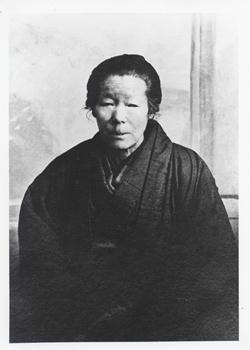
Shika Noguchi
|
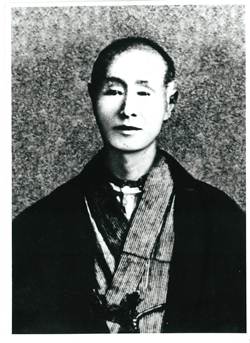
Sayosuke Noguchi |
When Seisaku was one and half years old, he fell onto a sunken fireplace and severely burned his left hand. His mother reproached herself throughout her lifetime about Seisaku’s deformed knobby left hand. Seisaku entered Mitsuwa Elementary School on his mother's advice in 1883. Although his family was poor and could not afford to buy even a new textbook, Seisaku studied hard and came to earn excellent results.
Just before his graduation from elementary school, he met Mr. Sakae Kobayashi, who became his lifelong teacher and mentor. Mr. Kobayashi came to the elementary school as an examiner and discovered Seisaku’s talent. He invited Seisaku and his mother to his home and recommended that Seisaku go to higher elementary school. Mr. Kobayashi looked after Seisaku during the four years of education in higher elementary school, and continued to take care of him and his family after that. |
|
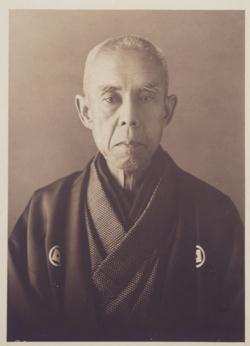
Mr. Sakae Kobayashi
|
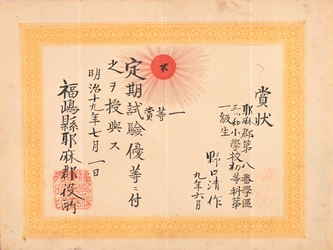
Certificate awarded to Seisaku for his excellent mark in an examination at elementary school |
Seisaku was able to undergo an operation on his left hand by Dr. Kanae Watanabe, the director of Kaiyo Hospital in Aizuwakamatsu City, with the support of his teacher and friends when he was in the fourth year of higher elementary school. Seisaku was so impressed with the excellence of medical science that, after he graduated from school, he entered Kaiyo Hospital as a live-in medical student and started to study to be a doctor. He was there for three years, reading a large number of foreign medical books with the help of a dictionary during any time he could spare. |
|
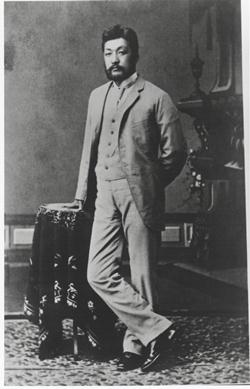
Dr. Kanae Watanabe |
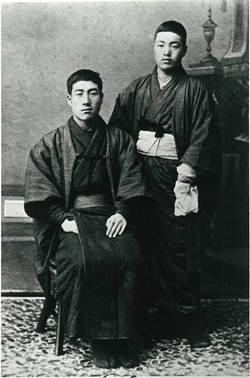
Seisaku (right) with Yasuhei Yago (left) after undergoing an operation on his left hand |
In 1896, Seisaku came to Tokyo to take the National Medical Practitioners Qualifying Examination. Just before he left his hometown for Tokyo with the resolution to become a doctor, he inscribed the phrase, “I shall not return to my native home if I do not achieve my objective,” on the alcove post of the house where he was born.
After he came to Tokyo, he passed the first half of the exam within that year. Then he passed the second half of the exam in the following year with the support of Dr. Morinosuke Chiwaki of Takayama Dental School, whom he had met at Kaiyo Hospital in Fukushima. Most people took several years to pass the national examination, but Seisaku managed to pass the exam in only one year and obtained a medical license at the age of only twenty. He did not become a practitioner in his hometown, but chose the path of engaging in medical study so that he could use his knowledge for the public as a bacteriologist. |
|
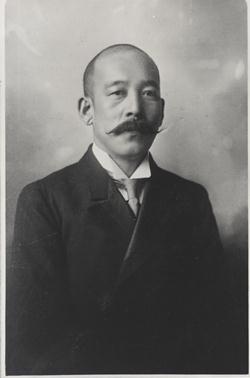
Dr. Morinosuke Chiwaki |
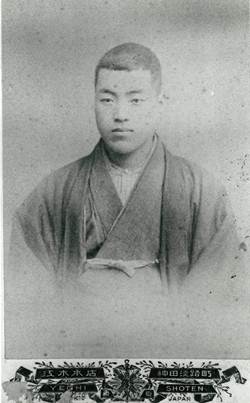
Seisaku coming to Tokyo |
In the summer of 1898, Seisaku read a novel entitled Tosei Shosei Katagi (Portraits of Contemporary Students) written by Shoyo Tsubouchi. In this novel, the main character, named "Seisaku Nonoguchi," was described as a promising medical student becoming evermore immoral. Seisaku reflected on his daily life, asked his former teacher, Mr. Sakae Kobayashi, for advice, and changed his name from Seisaku to Hideyo, reaffirming his determination. While he worked at Takayama Dental School, Juntendo Hospital, and Kitasato Institute for Infectious Diseases in Tokyo, he always hoped that he could study at an international level.
In December 1900, a ship with Hideyo aboard departed from Yokohama for the United States. It was a reckless journey. Hideyo planned to rely on Dr. Simon Flexner at University of Pennsylvania, but in fact Hideyo had little acquaintance with him. Hideyo had only served as an interpreter and a guide for Dr. Flexner while working at the Kitasato Institute.
His first mission at University of Pennsylvania was a study of snake venoms with a monthly salary of only 8 dollars. Although handling venomous snakes with his disabled left hand was dangerous work, he was absorbed in study under instruction from Dr. Silas Weir Mitchell, an authority on the study of snake venoms.
After being recognized for his study on snake venoms, he became a pathology assistant at University of Pennsylvania in 1902. In the following year, he became an assistant at Carnegie Institution of Washington, and went to study in Denmark. He learned about serology at Statens Serum Institut under the instruction of Dr. Thorvald Madsen.
When Hideyo came back from Denmark in 1904, he was appointed as an assistant by Dr. Flexner, the first director of the newly established Rockefeller Institute for Medical Research. Finally, he started full-fledged study, and began the challenging study of bacteria. |
|
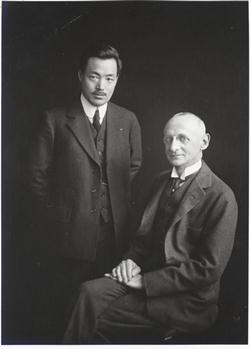
Hideyo and Dr. Flexner |
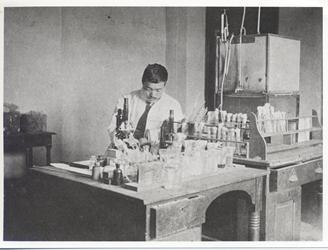
Hideyo in a laboratory at University of Pennsylvania |
His tenacity in his study was so amazing that people said, "When does Mr. Noguchi ever sleep?" and he published a large number of academic papers. In his study on syphilis spirochete, in particular, he made remarkable achievements, such as growing pure cultures and demonstrating the presence of syphilis spirochete in the brain of a patient with neurosyphilis, and was nominated as a leading candidate for the Nobel Prize. In Japan, he was awarded the Imperial Prize of the Japan Academy in 1915. |
|
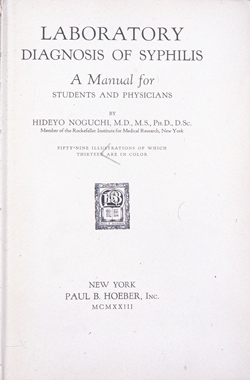
Hideyo’s research paper
|
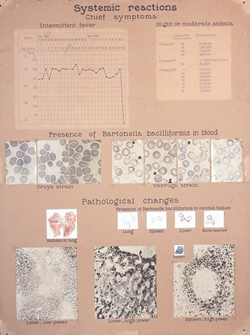
Presentation panel |
|
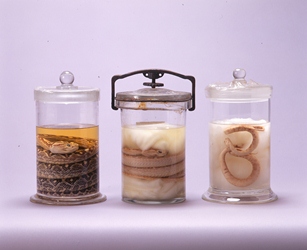
Specimens of venomous snakes collected by Hideyo |
In 1915, fifteen years after he crossed the Pacific Ocean alone, Hideyo returned to Japan from the United States. His two-month stay in Japan was filled with lecture meetings and welcome parties every day in Tokyo and other various locations. Being a good son, however, he took his mother and Mr. and Mrs. Kobayashi on a trip to the Kansai region in between his busy schedule and also strove to take time to repay the teachers and friends who had helped him. Having spent a busy but also peaceful time, Hideyo was seen off by many people as he left for the United States, promising to come back to Japan again. |
|
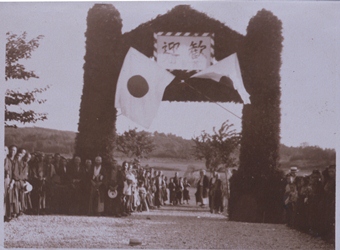
Hideyo welcomed by people in his hometown
|
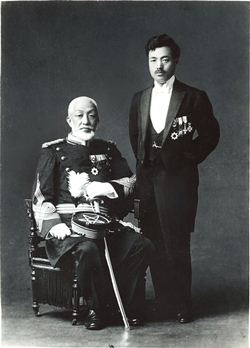
Together with Dr. Kanae Watanabe in commemoration of his receiving the decoration of the Order of the Rising Sun
|
|
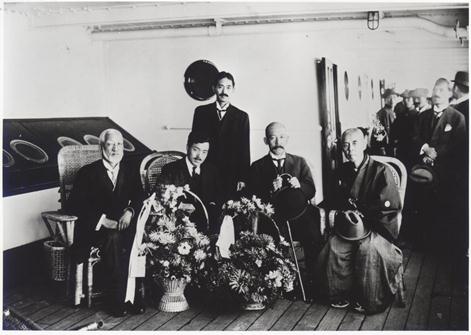
On the deck of a ship bound for the United States, together with Dr. Kanae Watanabe, Dr. Saburo Ishizuka, Dr. Morinosuke Chiwaki and Mr. Sakae Kobayashi |
In 1918, the Rockefeller Institute made a plan to send a study group to research a pandemic outbreak of yellow fever in Latin America. Hideyo applied, and went to Santiago de Guayaquil, Republic of Ecuador. His fight against yellow fever started from this time. He obtained excellent results from his hard work around the clock, but as yellow fever also broke out in Mexico, Peru, and Brazil one after another, he continued his study to fight against the disease without rest. |
|
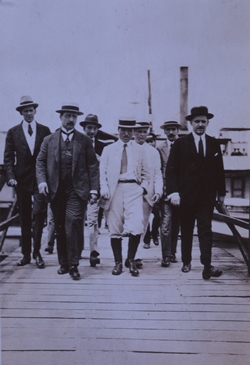
Hideyo landing in Santiago de Guayaquil
|
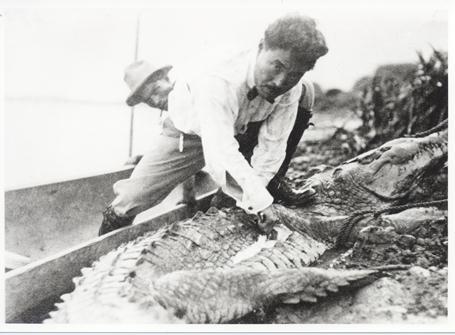
Hideyo hunting and dissecting crocodiles on the Rio Grande River |
Nevertheless, there were some researchers who engaged in different studies and held different views on the disease, doubting Hideyo’s theories. Around that time, the death of one of his colleague researchers from yellow fever in Lagos, Africa, triggered Hideyo’s embarking on a study trip to Africa, despite the objections of people around him, in order to solve all the questions that remained with regard to yellow fever.
In 1927, Hideyo visited Africa. He extended his stay from three to six months and investigated the cause of yellow fever. In 1928, at the end of March, he finally began to see the end of his struggle with yellow fever. |
|
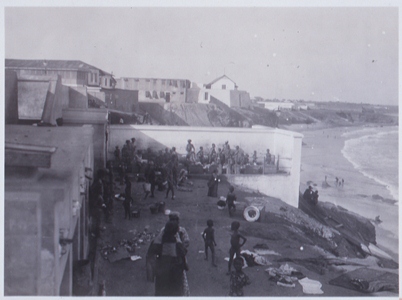
Hideyo stepping foot onto the Gold Coast in West Africa |
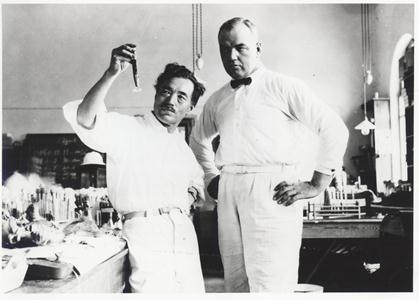
Together with Dr. Alexander Mahaffey
|
When methods to prevent and treat yellow fever were almost in sight and Hideyo went to a meeting at the headquarters in Lagos, Nigeria, to discuss his return to the United States, he himself contracted yellow fever. In spite of intensive treatment back in Accra, he remarked, “I don’t understand,” and his life ended at the young age of fifty one on May 21, 1928.
Dr. Hideyo Noguchi, who contributed to humanity through medical science, still lives in our hearts today. |




















